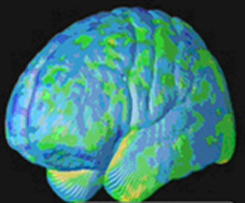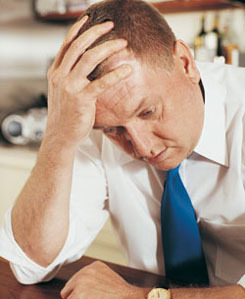
Bipolar Disorder, also known as manic-depressive illness, is a serious medical illness that causes shifts in a person's mood, energy, and ability to function.
Different from the normal ups and downs that everyone goes through, the symptoms of bipolar disorder are severe.
Bipolar disorder, also known as manic-depressive illness
Biploar disorder is a form of depression. It is a brain disorder that causes unusual shifts in a person's mood, energy, and ability to function. Different from the normal ups and downs that everyone goes through, the symptoms of bipolar disorder are severe. They can result in damaged relationships, poor job or school performance, and even suicide. But there is good news: bipolar disorder can be treated, and people with this illness can lead full and productive lives.
About 5.7 million American adults or about 2.6 percent of the population age 18 and older in any given year,1 have bipolar disorder. Bipolar disorder typically develops in late adolescence or early adulthood. However, some people have their first symptoms during childhood, and some develop them late in life. It is often not recognized as an illness, and people may suffer for years before it is properly diagnosed and treated. Like diabetes or heart disease, bipolar disorder is a long-term illness that must be carefully managed throughout a person's life.
Signs And Symptoms
Most people with bipolar disorder can achieve substantial stabilization of their mood swings and related symptoms over time with proper treatment. A strategy that combines medication and psychosocial treatment is optimal for managing the disorder over time.
Bipolar disorder causes dramatic mood swings-from overly "high" and/or irritable to sad and hopeless, and then back again, often with periods of normal mood in between. Severe changes in energy and behavior go along with these changes in mood. The periods of highs and lows are called episodes of mania and depression.
Signs and symptoms of mania (or a manic episode) include:
- Increased energy, activity, and restlessness
- Excessively "high," overly good, euphoric mood
- Extreme irritability
- Racing thoughts and talking very fast, jumping from one idea to another
- Distractibility, can't concentrate well
- Little sleep needed
- Unrealistic beliefs in one's abilities and powers
- Poor judgment
- Spending sprees
- A lasting period of behavior that is different from usual
- Increased sexual drive
- Abuse of drugs, particularly cocaine, alcohol, and sleeping medications
- Provocative, intrusive, or aggressive behavior
- Denial that anything is wrong
A manic episode is diagnosed if elevated mood occurs with three or more of the other symptoms most of the day, nearly every day, for 1 week or longer. If the mood is irritable, four additional symptoms must be present.
Signs and symptoms of depression (or a depressive episode) include:

- Lasting sad, anxious, or empty mood
- Feelings of hopelessness or pessimism
- Feelings of guilt, worthlessness, or helplessness
- Loss of interest or pleasure in activities once enjoyed, including sex
- Decreased energy, a feeling of fatigue or of being "slowed down"
- Difficulty concentrating, remembering, making decisions
- Restlessness or irritability
- Sleeping too much, or can't sleep
- Change in appetite and/or unintended weight loss or gain
- Chronic pain or other persistent bodily symptoms that are not caused by physical illness or injury
- Thoughts of death or suicide, or suicide attempts
A depressive episode is diagnosed if five or more of these symptoms last most of the day, nearly every day, for a period of 2 weeks or longer.
A mild to moderate level of mania is called hypomania. Hypomania may feel good to the person who experiences it and may even be associated with good functioning and enhanced productivity. Thus even when family and friends learn to recognize the mood swings as possible bipolar disorder, the person may deny that anything is wrong. Without proper treatment, however, hypomania can become severe mania in some people or can switch into depression.
Sometimes, severe episodes of mania or depression include symptoms of psychosis (or psychotic symptoms). Common psychotic symptoms are hallucinations (hearing, seeing, or otherwise sensing the presence of things not actually there) and delusions (false, strongly held beliefs not influenced by logical reasoning or explained by a person's usual cultural concepts). Psychotic symptoms in bipolar disorder tend to reflect the extreme mood state at the time. For example, delusions of grandiosity, such as believing one is the President or has special powers or wealth, may occur during mania; delusions of guilt or worthlessness, such as believing that one is ruined and penniless or has committed some terrible crime, may appear during depression. People with bipolar disorder who have these symptoms are sometimes incorrectly diagnosed as having schizophrenia, another severe mental illness.
It may be helpful to think of the various mood states in bipolar disorder as a spectrum or continuous range. At one end is severe depression, above which is moderate depression and then mild low mood, which many people call "the blues" when it is short-lived but is termed "dysthymia" when it is chronic. Then there is normal or balanced mood, above which comes hypomania (mild to moderate mania), and then severe mania.
A double-sided arrow listing range of moods, from severe mania to severe depression
In some people, however, symptoms of mania and depression may occur together in what is called a mixed bipolar state. Symptoms of a mixed state often include agitation, trouble sleeping, significant change in appetite, psychosis, and suicidal thinking. A person may have a very sad, hopeless mood while at the same time feeling extremely energized.
Bipolar disorder may appear to be a problem other than mental illness-for instance, alcohol or drug abuse, poor school or work performance, or strained interpersonal relationships. Such problems in fact may be signs of an underlying mood disorder.

Getting Help: Locate Services
Locate Mental Health Services in Your Area
Within the Federal government, the Substance Abuse and Mental Health Services Administration (SAMHSA) offers a Services Locator for mental health and substance abuse treatment programs and resources nationwide.
 Print
Print Email
Email







